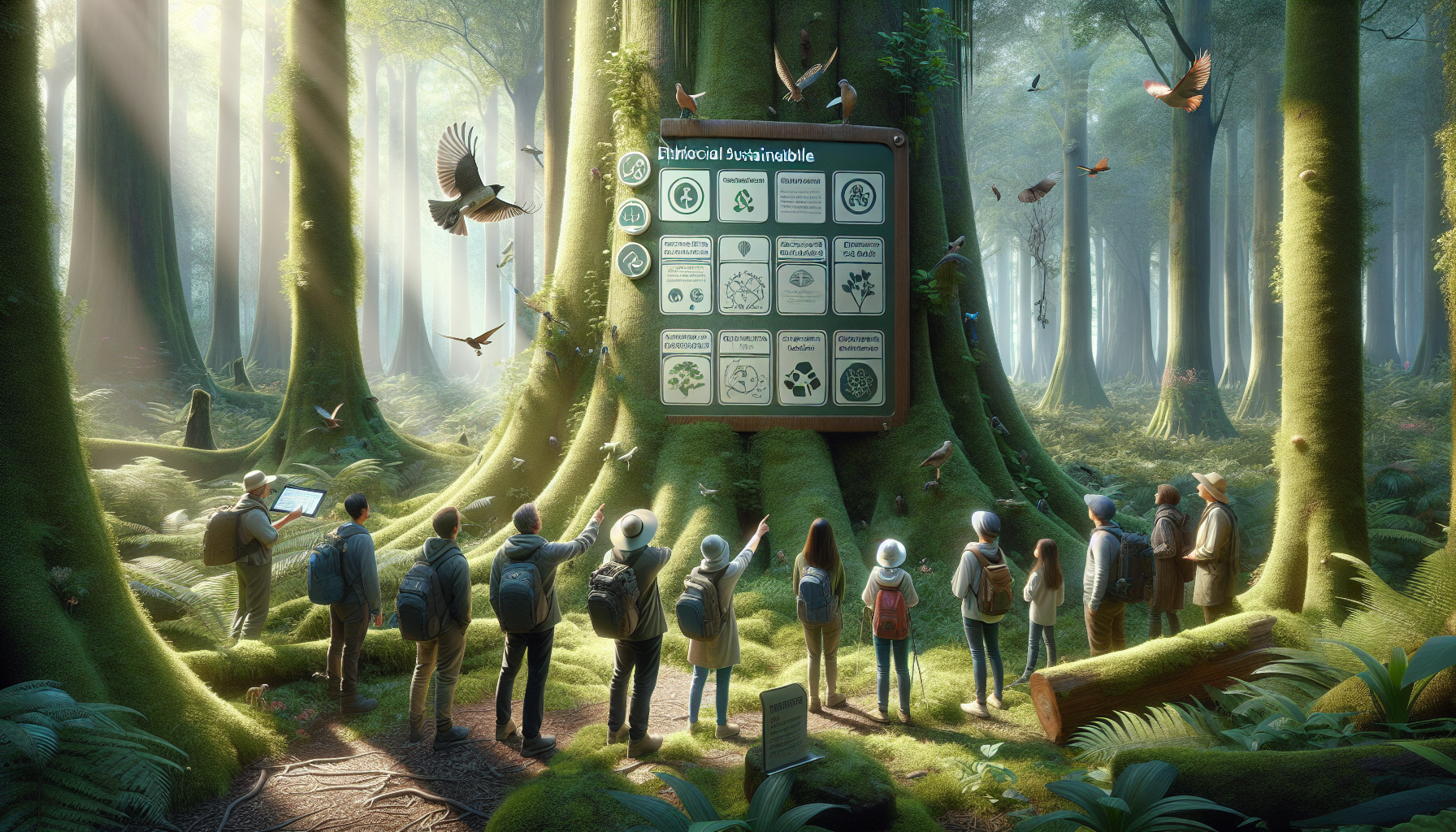In the heart of our planet’s most pristine landscapes lies an ancient guardian, a silent protector that has been nurturing life for millennia—the forest. These verdant expanses, with their towering canopies and rich undergrowth, are much more than just a collection of trees; they are the lungs of the Earth, a sanctuary for countless species, and a vital component in the fight against climate change. 🌍 As we stand at the crossroads of environmental sustainability and ecological responsibility, it becomes imperative to explore how we can coexist harmoniously with these natural wonders. Welcome to “Guardians of the Green: Exploring Forests with Ethical Guidelines for a Sustainable Future,” a journey into the heart of the world’s forests and the ethical principles that must guide our stewardship of these essential ecosystems.
Forests, covering about 31% of the world’s land area, are critical in maintaining ecological balance. They provide habitat for over 80% of terrestrial species, act as major carbon sinks, and offer countless resources and services that sustain both local and global communities. Yet, despite their importance, forests are under siege. Deforestation, driven by logging, agriculture, and urbanization, is occurring at an alarming rate—an estimated 10 million hectares are lost each year. This destruction not only jeopardizes biodiversity but also exacerbates climate change, leading to a cascade of environmental challenges. In this article, we will delve into the core reasons why forests are invaluable and examine the devastating impact of their loss on our planet.
The key to preserving these vital ecosystems lies in ethical forest management and sustainable practices. Ethical guidelines provide a framework that balances human needs with environmental protection, ensuring that forests continue to thrive for generations to come. From sustainable logging practices and reforestation efforts to community-based conservation initiatives, there are numerous strategies that can be employed to safeguard our forests. We will explore these methodologies, highlighting successful case studies from around the globe that demonstrate how thoughtful stewardship can lead to positive outcomes for both people and the planet.
Moreover, the role of technology and innovation in forest conservation cannot be overlooked. Advances in satellite monitoring, drone technology, and data analytics are revolutionizing the way we understand and manage forest ecosystems. These tools offer unprecedented insights into forest health, enabling more effective monitoring and enforcement of conservation policies. In this article, we will discuss how these technological advancements are being leveraged to combat deforestation and promote sustainable land management practices. We will also consider the ethical implications of these technologies and how they can be used to support, rather than hinder, indigenous communities who have long been the true guardians of the green.
Finally, we must address the crucial role that education and advocacy play in forest conservation. Awareness is the first step towards action, and by educating ourselves and others about the importance of forests and the threats they face, we can galvanize collective efforts to protect them. This article will outline ways in which individuals, communities, and organizations can engage in advocacy efforts, from grassroots campaigns to international collaborations. By fostering a deeper connection to our planet’s forests and understanding our responsibility towards them, we can ensure that these magnificent ecosystems continue to flourish and support life on Earth. 🌳
Understanding the Importance of Forests in Our Ecosystem
Forests are often referred to as the lungs of our planet, playing a crucial role in maintaining ecological balance. They cover about 31% of the world’s land area and are home to more than 80% of the terrestrial biodiversity. The diverse ecosystems within forests, ranging from tropical rainforests to boreal forests, provide essential services that are vital for life on Earth.
Forests are significant carbon sinks, absorbing large amounts of carbon dioxide and helping mitigate climate change. They store carbon in biomass, soils, and dead organic matter, which is critical in regulating the Earth’s climate. Furthermore, forests influence weather patterns and precipitation. The Amazon rainforest, for instance, generates more than 50% of its own precipitation through evapotranspiration, demonstrating its vital role in the regional climate.
Beyond their ecological functions, forests are fundamental to human survival. They provide resources such as timber, non-timber forest products, and medicine. Forests are also a source of livelihood for millions of people around the world, including indigenous communities that rely on them for cultural and spiritual values. However, unsustainable practices, such as deforestation and illegal logging, threaten these critical ecosystems, leading to biodiversity loss and climate instability.
The Role of Ethical Guidelines in Forest Conservation
Implementing ethical guidelines in forest conservation is crucial for achieving sustainability. These guidelines ensure that forest resources are managed in a way that meets the needs of the present without compromising the ability of future generations to meet their own needs. Ethical guidelines promote sustainable forest management, which balances environmental, economic, and social objectives.
One of the primary ethical considerations in forest conservation is respecting the rights of indigenous and local communities. These groups have traditional knowledge and practices that have preserved forests for generations. Recognizing and integrating their rights into conservation policies is vital for the success of any conservation strategy. Additionally, ethical guidelines advocate for the equitable distribution of benefits derived from forest resources, ensuring that local communities benefit from conservation efforts.
Adopting a holistic approach to forest conservation that incorporates ethical guidelines can lead to more sustainable outcomes. This includes promoting practices such as selective logging, agroforestry, and reforestation, which help maintain forest cover while providing economic benefits. Ethical guidelines also emphasize the importance of stakeholder engagement, ensuring that all parties involved have a voice in decision-making processes.
Comparative Analysis of Sustainable Forest Management Practices
| Practice | Description | Advantages | Challenges |
|---|---|---|---|
| Selective Logging | Harvesting selected trees to minimize ecological impact. | Preserves forest structure, promotes regeneration. | Requires skilled labor, can be economically less lucrative. |
| Agroforestry | Integrating trees with agricultural crops. | Enhances biodiversity, improves soil health. | Complex management, potential competition for resources. |
| Reforestation | Planting trees in deforested areas. | Restores ecosystems, enhances carbon sequestration. | Initial costs can be high, requires ongoing maintenance. |
Check out the video below to gain more insights into sustainable forest management practices:
Sustainable Forest Management – ABC Environment
Challenges and Opportunities in Forest Conservation
While forest conservation efforts have gained momentum, several challenges persist. Deforestation, driven by agriculture, urbanization, and illegal logging, remains a significant threat. The conversion of forest land into agricultural use is particularly prevalent in tropical regions, where it leads to habitat destruction and biodiversity loss.
In addition to deforestation, climate change poses a threat to forests by altering growth patterns and increasing the frequency of wildfires and pest outbreaks. These changes can lead to shifts in species distribution and forest composition, impacting ecosystem services.
Despite these challenges, there are opportunities for innovation and collaboration in forest conservation. Technological advancements, such as remote sensing and GIS, enable better monitoring and management of forest resources. These tools can improve the accuracy of data collection, facilitating more informed decision-making.
- Embrace community-based conservation efforts that empower local populations.
- Implement incentive-based mechanisms to encourage sustainable practices.
- Foster global cooperation to address transboundary forest conservation issues.
Innovative Approaches for a Sustainable Future
To secure a sustainable future for forests, innovative approaches are essential. One promising approach is the use of blockchain technology to enhance transparency and traceability in the supply chain. By ensuring that forest products are sourced sustainably, blockchain can help combat illegal logging and promote responsible consumption.
The integration of traditional ecological knowledge with modern scientific methods offers another avenue for innovation. Indigenous communities possess valuable knowledge about forest ecosystems, which can be combined with contemporary research to develop more effective conservation strategies.
Educational initiatives are also crucial for fostering a culture of sustainability. By raising awareness about the importance of forests and promoting sustainable practices, these initiatives can inspire individuals and communities to take action.
🌿 As you explore the potential of forests and ethical guidelines, consider how you can contribute to their sustainable future. Whether through supporting conservation efforts, advocating for policy changes, or making conscious consumption choices, every action counts towards preserving these vital ecosystems.

Conclusion
In conclusion, the exploration of our forests through ethical guidelines is not just a call to action but a necessity for ensuring a sustainable future. Throughout this article, we have journeyed through the intricate layers of forest ecosystems, the essential role they play in maintaining biodiversity, and their immense contribution to the well-being of our planet and society. We’ve delved into the ethical considerations and sustainable practices that must be adopted to protect these vital resources, emphasizing that our actions today will shape the future of our natural world.
Forests are more than just collections of trees; they are vibrant ecosystems that support a vast array of life forms. They are home to countless species, many of which are still undiscovered, and they provide essential services such as carbon sequestration, water regulation, and soil conservation. By understanding these complex systems, we can appreciate the profound impact they have on global health and climate stability.
Our discussion highlighted the urgent need for ethical guidelines in forest exploration and conservation. Sustainable practices are crucial to mitigate deforestation and habitat destruction, which threaten not only plant and animal species but also the indigenous communities that depend on forests for their livelihoods. Ethical exploration involves respecting the rights of these communities, acknowledging their knowledge and traditions, and ensuring they are active participants in conservation efforts.
Furthermore, we explored innovative strategies and technologies that can aid in forest conservation. From remote sensing and satellite monitoring to community-driven conservation projects, there are myriad ways to engage in effective forest management. These tools enable us to monitor changes in forest cover, identify areas of concern, and implement measures to preserve these vital ecosystems.
The importance of forests in combating climate change cannot be overstated. They act as carbon sinks, absorbing CO2 from the atmosphere and helping to regulate global temperatures. By preserving and expanding our forests, we can significantly reduce greenhouse gas emissions and contribute to a more stable climate.
It’s crucial to recognize that forest conservation is not solely the responsibility of governments and organizations. Individuals, too, have a role to play. By making conscious choices—such as supporting sustainable products, reducing waste, and advocating for policies that protect natural resources—we can collectively contribute to the preservation of our forests.
As we conclude, I urge you to reflect on the insights shared in this article and consider how you can be a guardian of the green. 🌿 Whether you’re a researcher, policy-maker, educator, or concerned citizen, your actions matter. Share this knowledge with your community, engage in discussions, and inspire others to take action. By working together, we can ensure that our forests continue to thrive for generations to come.
For further exploration and research, consider visiting these active resources:
– World Wildlife Fund: Forests
– Rainforest Alliance: Our Work
By engaging with these resources, you can deepen your understanding of forest conservation efforts and discover ways to contribute to this vital cause. Thank you for joining us on this journey through the heart of our planet’s green guardians.
Toni Santos is a visual storyteller and symbolic naturalist whose creations explore the hidden ecologies and forgotten bonds between humans and nature, as whispered through ancient lore. Through an intuitive and myth-sensitive lens, Toni reveals the sacred choreography between flora, fauna, and human spirit — a world where trees once spoke, rivers remembered, and every herb carried a secret name.
His journey is rooted in the esoteric — in the rituals of forest-dwellers, the botanical codes of shamans, and the unspoken pacts that shaped how ancient peoples lived in deep, reciprocal harmony with the natural world. From sacred groves to serpent-guarded springs, each of Toni’s works reflects a symbolic relationship long obscured by modern forgetfulness.
With a background in visual design and ancestral aesthetics, Toni merges storytelling with sacred ecology. His pieces don’t simply illustrate — they channel. Drawing from myth, mysticism, and lost herbal traditions, he crafts visuals that resonate with the old wisdom: that nature is not background, but kin.
As the creative spirit behind Vizovex, Toni shares collections, visual studies, and articles that illuminate the occulted connections between human life and the wild world. His work calls on us to remember — not just with the mind, but with the senses and the soul — the profound dialogues our ancestors once had with earth, plant, and animal.
His work is a tribute to:
The mythic language of trees, stones, and roots
Forgotten pacts between healers and the wilderness
The sacred knowledge carried in nature’s unseen patterns
Whether you’re a seeker of ancient plant-lore, a mystic attuned to seasonal cycles, or simply someone who hears the forest speak, Toni welcomes you to wander a space where symbolism, nature, and spirit entwine — one myth, one leaf, one vision at a time.




